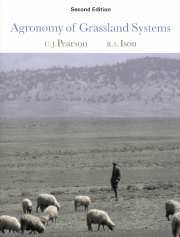Book contents
- Frontmatter
- Contents
- Preface
- 1 Overview: perspectives on grassland systems
- 2 The emergence of grassland systems
- 3 Generation
- 4 Vegetative growth
- 5 Flowering and seed production
- 6 Mineral nutrition
- 7 Herbage quality and animal intake
- 8 Grassland – animal interactions and management
- 9 Grassland systems design
- References
- Index
3 - Generation
Published online by Cambridge University Press: 05 June 2012
- Frontmatter
- Contents
- Preface
- 1 Overview: perspectives on grassland systems
- 2 The emergence of grassland systems
- 3 Generation
- 4 Vegetative growth
- 5 Flowering and seed production
- 6 Mineral nutrition
- 7 Herbage quality and animal intake
- 8 Grassland – animal interactions and management
- 9 Grassland systems design
- References
- Index
Summary
Seed constitutes both the start and the end of the life cycle of most plants. This life cycle involves seedling generation, survival and growth, flowering and further seed formation and the addition of this seed to the soil (Fig. 1.5). In sown grasslands the biological processes associated with generation can be seen to occur within a larger system associated with grassland establishment (Fig. 3.1), which incorporates commercial seed production (see Chapter 4).
Structural and morphological differences exist among seeds (Fig. 3.2), seedlings (Fig. 4.2) and mature plants. In this chapter we are concerned mainly with the seeds from plants of the families Poaceae (monocotyledonous, grasses) and Fabaceae (dicotyledonous, legumes). These families are the most common in grasslands; they occur in ‘natural’ grasslands and they have been actively collected and selected for sowing. Unlike the case for species selected as food crops from these same families, seed size has not been a major criterion for selection of herbage plants and thus the majority of herbage species in use today have small seeds that weigh less than 2 mg (Table 3.1). Some fodder and dual-purpose species are exceptions.
In this chapter we consider first the sources of seed and the means by which this seed enters the soil and then describe the fate of this seed by following a conceptual model (Fig. 3.3) in which seed can be lost through various pathways or filters as it progresses through germination.
- Type
- Chapter
- Information
- Agronomy of Grassland Systems , pp. 37 - 59Publisher: Cambridge University PressPrint publication year: 1997

